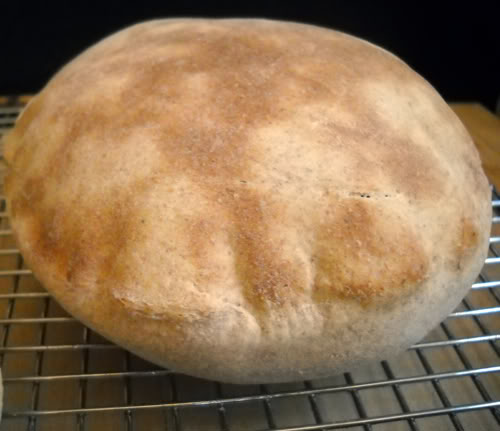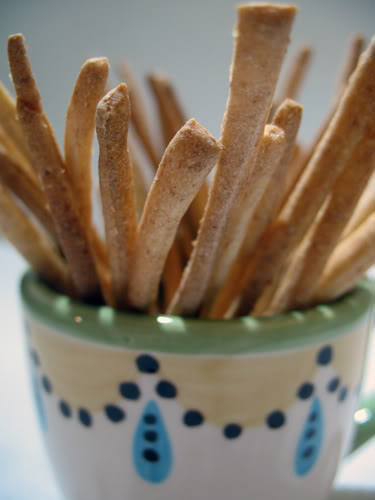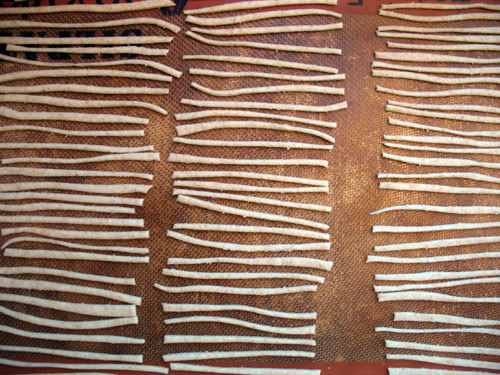
Waaay back in the TBS (Time Before Stephen), when I was a marketing exec at a book publisher and dreaming about opening a prepared-foods shop, I took some classes at the Institute of Culinary Education. It seemed like the smart thing to do, to get some actual training in a kitchen, to learn how to cook without a recipe. One of the courses I took was devoted to bread baking, which had intrigued me, oh, forever—I’ve told you before about baking challah with my mom on Friday afternoons. Each week we’d come in and learn about a different type of bread: firm-textured sandwich bread; long, elegant baguettes that crackled when we broke them open; herb-flecked peasant breads; and whole-grain loaves packed with fruits and nuts.
These days I don’t bake bread as often as I’d like—which is silly, thanks to the no-knead, bake-in-a-Dutch-oven method popularized by Jim Lahey (whose pizza dough I’ve told you about several times). It doesn’t exactly take a lot of brain power. And yet… Bread baking is just not a regular activity around here. Partly it’s the fact that I’m on Weight Watchers, and I know I’ll eat far too much of any bread I bake myself. And partly it’s the fact that I’ve been feeling a little overextended for the last year-plus (hello, almost-neverending project!) But I still like to browse through my cookbooks, even the ones that are sadly neglected—it’s so easy, since they’re still stacked in the hallway outside my bedroom while we wait for the guys to come fix the leak damage from two months ago. And the other day, as I thumbed through a bread book while drifting off to sleep, I discovered the most overextended-parent-friendly bread recipe ever.
The book: Peter Reinhart’s The Bread Baker’s Apprentice: Mastering the Art of Extraordinary Bread.
The recipe: Lavash Crackers.
The parent-friendly twist: In a sidebar, Reinhart mentions that this same dough will make lovely pita bread. And on another page entirely, a sidebar about breadsticks mentions that, yes, this very same dough will also make snappy sticks. Sound the alarm! I had to try it.
This is cause for celebration, my friends. The dough came together easily; both the pita and the lavash formed with almost no effort. The breadsticks, I’ll be honest, were time-consuming. Cutting all those wee pieces and transferring them to the baking sheet is a bit fiddly if you’re brain-dead, but it’s also strangely comforting. All that rhythmic movement. And the end results were nearly as satisfying as finishing the damned cookbook. It’s all the same dough, but the different textures make each product taste different—the pita’s fluffy and chewy; the lavash shatters under your teeth with big studs of sea salt; and the breadsticks are nothing short of addictive. Harry had a playdate the day after I baked them off, and the two kids made mincemeat of those crispy sticks. Yeah, mixed metaphor, whatever. Give this dough a try. You won’t be sorry.
One Whole Wheat Dough, Three Breads
Adapted from Peter Reinhart’s The Bread Baker’s Apprentice: Mastering the Art of Extraordinary Bread
Makes 6 pita breads OR 2 trays of lavash crackers OR around 150 thin, short breadsticks (or divide the dough into thirds and make a little of each)
1 cup unbleached bread flour
1/2 cup whole wheat bread flour
1/2 teaspoon salt
1/2 teaspoon instant yeast
1 tablespoon honey
1 tablespoon vegetable oil
1/3 to 1/2 cup water, at room temperature
Kosher salt, cracked black pepper, and/or your choice of seeds, for topping lavash
- In a mixing bowl, stir together the flour, salt, yeast, honey, oil, and just enough water to bring everything together into a ball—I only needed 1/3 cup, though you may need the full 1/2 cup.
- Sprinkle a clean workspace lightly with flour and place the dough on top. (I use a Roul’Pat Pastry Mat.
) Knead for about 10 minutes, until the dough is satin-smooth and stretches quite thin. It will be pretty firm, but not crazily so. Lightly oil a bowl and place the dough inside, rolling it to cover with oil. Cover the bowl with plastic wrap.
- Let it rise for about 90 minutes, or until roughly doubled in size.

TO MAKE PITA: Heat the oven to 500°F. Cut the dough into 6-ounce pieces, and roll each one out to a circle about 8 inches in diameter—it’ll be thin, but not cracker-thin. Transfer to a sheet pan and bake for 3 to 5 minutes, just until they form a pocket. Count to 10, then remove the pan from the oven—wait too long and they’ll begin to crisp. (I had some trouble getting a visual since I’ve got a crappy oven, but even so it was clear when they’d inflated.) Cool on a rack.

TO MAKE LAVASH: Heat the oven to 350°F; line two baking sheets and set aside. Spray the counter lightly with oil and transfer the dough to the counter. (If you’re working on a Roul’Pat, there’s no need to spray; the dough won’t stick.) To make a full recipe’s worth of crackers, cut the dough in half and roll each half separately, as thin as you can. Each piece should roll out to be nearly as big as the baking sheet—take care to roll evenly, though, or one part of the dough might become too browned before another is fully baked. Carefully transfer the rolled-out dough to the baking sheets. Mist the top of the dough with water and sprinkle whatever salts or spices you like on top (I used kosher salt and black pepper). If you want to pre-cut your crackers, use a pizza cutter—no need to separate the pieces. If you want a more rustic effect, leave it whole and break into shards later.

Bake for 15 to 20 minutes, rotating the trays halfway through if your oven’s as wonky as mine. They’re done when the entire surface is a deep caramelly brown. Let the crackers cool for about 10 minutes in the pan before you break them apart or snap into shards.

TO MAKE BREADSTICKS: Heat the oven to 325°F and line two baking sheets. Lightly dust your work surface with flour (again, with a Roul’Pat you won’t need to do this). Cut the dough into quarters and roll them out one at a time, keeping the others covered. No need to go super-thin; my dough was about 1/4-inch thick. Use a pizza cutter to cut them into breadsticks, however long and thin you want—just know that the baking time will vary depending on size. Transfer the sticks to the baking sheets and arrange in rows—it’s fine for them to be quite close together. If you want flavored sticks, first mist with water, then sprinkle with whatever seasonings you like. (If you want to get fancy, you can give each stick a twist or two, but that’s too much work for me!) Bake for 12 to 15 minutes, rotating after 7 minutes to ensure even baking. Cool in the pan for a few minutes before transferring to a rack.

MAKE BABY FOOD: Breadsticks are terrific for gumming (just keep a close watch, in case a piece snaps off in baby’s mouth), as is pita. The lavash is probably pushing it, since those shards can break off mighty sharp.
